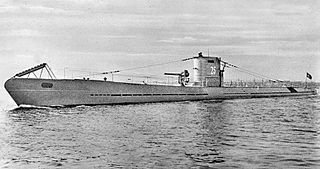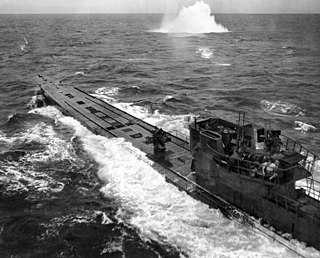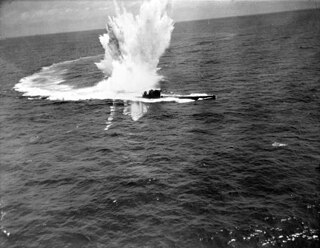
The Type IX U-boat was designed by Nazi Germany's Kriegsmarine in 1935 and 1936 as a large ocean-going submarine for sustained operations far from the home support facilities. Type IX boats were briefly used for patrols off the eastern United States in an attempt to disrupt the stream of troops and supplies bound for Europe. It was derived from the Type IA, and appeared in various sub-types.

The Type XIV U-boat was designed to resupply other U-boats, being the only submarine tenders built which were not surface ships. It was nicknamed in German the "Milchkuh/Milchkühe (pl.)".

German Type XXIII submarines were the first so-called elektroboote to become operational. They were small coastal submarines designed to operate in the shallow waters of the North Sea, Black Sea and Mediterranean Sea, where larger Type XXI electric boats were at risk in World War II. They were so small they could carry only two torpedoes, which had to be loaded externally. As with their far larger sisters—the Type XXI—they were able to remain submerged almost all of the time and were faster than conventional U-boats, due to the improved streamlining of their shape, batteries with larger capacity and the snorkel, which allowed the diesel engines to be used while submerged. The Type XXI and XXIII U-boats revolutionized post-war submarine design. Nearly a thousand Type XXIII boats were projected towards the close of World War II, but most of these were either cancelled, scrapped incomplete, or only projected.

The Type I U-boat was the first post–World War I attempt to produce an oceangoing submarine for Nazi Germany's Kriegsmarine. The type was based on the Spanish Type E-1 and Finnish CV707, which were both designed by Ingenieurskantoor voor Scheepsbouw. Only two Type IAs were built. They were not a successful design : due to its single rudder they had a large turning circle and were not very manoeuvrable. The gravity center of the U-boat was too forward so on surface the type I had its propellers exposed when she was pitching. Whilst submerged there were problems with depth keeping and stability as air bubbles in fuel tanks wobbled back and forth. Diving was very slow : at full speed and with six tons of negative buoyancy it took forty seconds to reach ten metres depth. As a result, the type was discontinued and a new type IX class oceangoing U-boats was designed.

German submarine U-234 was a Type XB U-boat of Nazi Germany's Kriegsmarine during World War II, she was commanded by Kapitänleutnant Johann-Heinrich Fehler. Her first and only mission into enemy or contested territory consisted of the attempted delivery of uranium oxide and German advanced weapons technology to the Empire of Japan. After receiving Admiral Dönitz' order to surface and surrender and of Germany's unconditional surrender, the submarine's crew surrendered to the United States on 14 May 1945.
German submarine U-219 was a Type XB submarine of Nazi Germany's Kriegsmarine during World War II. The U-boat was laid down on 31 May 1941 at the Germaniawerft yard at Kiel as yard number 625, launched on 6 October 1942, and commissioned on 12 December 1942 under the command of Korvettenkapitän Walter Burghagen.
German submarine U-181 was a Type IXD2 U-boat of Germany's Kriegsmarine during World War II. The submarine was laid down on 15 March 1941 at the DeSchiMAG AG Weser yard at Bremen as yard number 1021. She was launched on 30 December 1941 and commissioned on 9 May 1942 under the command of Kapitänleutnant Wolfgang Lüth. After training with the 4th U-boat Flotilla at Stettin, U-181 was attached to the 10th flotilla for front-line service on 1 October 1942, then transferred to the 12th flotilla on 1 November.

The Type XVII U-boats were small coastal submarines that used a high-test peroxide propulsion system, which offered a combination of air-independent propulsion and high submerged speeds.
German submarine U-843 was a Type IXC/40 U-boat of the German Kriegsmarine during World War II. The submarine was laid down on 21 April 1942 at the DeSchiMAG AG Weser yard in Bremen, launched on 15 December 1942, and commissioned on 24 March 1943 under the command of Kapitänleutnant Oskar Herwartz. After training with 4th U-boat Flotilla in the Baltic Sea, U-843 was transferred to 2nd U-boat Flotilla on 1 November 1943 for front-line service, and was transferred to 33rd U-boat Flotilla on 1 October 1944. She carried out three war patrols, sinking one ship, and was sunk by a British aircraft on 9 April 1945.
German submarine U-1059 was a Type VIIF transport submarine of Nazi Germany's Kriegsmarine during World War II.
German submarine U-1062 was one of a series of four Type VIIF submarine of Nazi Germany's Kriegsmarine during World War II.

The Gruppe Monsun or Monsoon Group was a force of German U-boats (submarines) that operated in the Pacific and Indian Oceans during World War II. Although similar naming conventions were used for temporary groupings of submarines in the Atlantic, the longer duration of Indian Ocean patrols caused the name to be permanently associated with the relatively small number of U-boats operating out of Penang. After 1944, the U-boats of the Monsun Gruppe were operationally placed under the authority of the Southeast Asia U-boat Region.

German submarine U-233 was a Type XB U-boat of Nazi Germany's Kriegsmarine during World War II. She was laid down on 15 August 1941, launched on 8 May 1943 and commissioned on 22 September of the same year. U-233 was commanded throughout her career by Oberleutnant zur See Hans Steen.

German submarine U-117 was a Type XB minelaying U-boat of Nazi Germany's Kriegsmarine during World War II.
German submarine U-616 was a Type VIIC U-boat built for Nazi Germany's Kriegsmarine, for service during World War II. She was laid down on 20 May 1941 by Blohm & Voss, Hamburg as yard number 592, launched on 8 February 1942 and commissioned on 2 April 1942 under Oberleutnant zur See (Oblt.z.S.) Johann Spindlegger.
German submarine U-225 was a Type VIIC U-boat of Nazi Germany's Kriegsmarine during World War II.

German submarine U-118 was a Type XB minelaying U-boat of Nazi Germany's Kriegsmarine during World War II.
German submarine U-119 was a Type XB minelaying U-boat of Nazi Germany's Kriegsmarine during World War II. She was laid down at the Germaniawerft in Kiel on 15 May 1940 as yard number 624. She was launched on 6 January 1942 and commissioned under Kapitänleutnant Alois Zech on 2 April 1942, he was replaced by Kptlt. Horst-Tessen von Kameke on 15 April 1943, who remained in command until her loss.
German submarine U-220 was a Type XB submarine of Nazi Germany's Kriegsmarine during World War II.

German submarine U-243 was a Type VIIC U-boat of Nazi Germany's Kriegsmarine during World War II.











